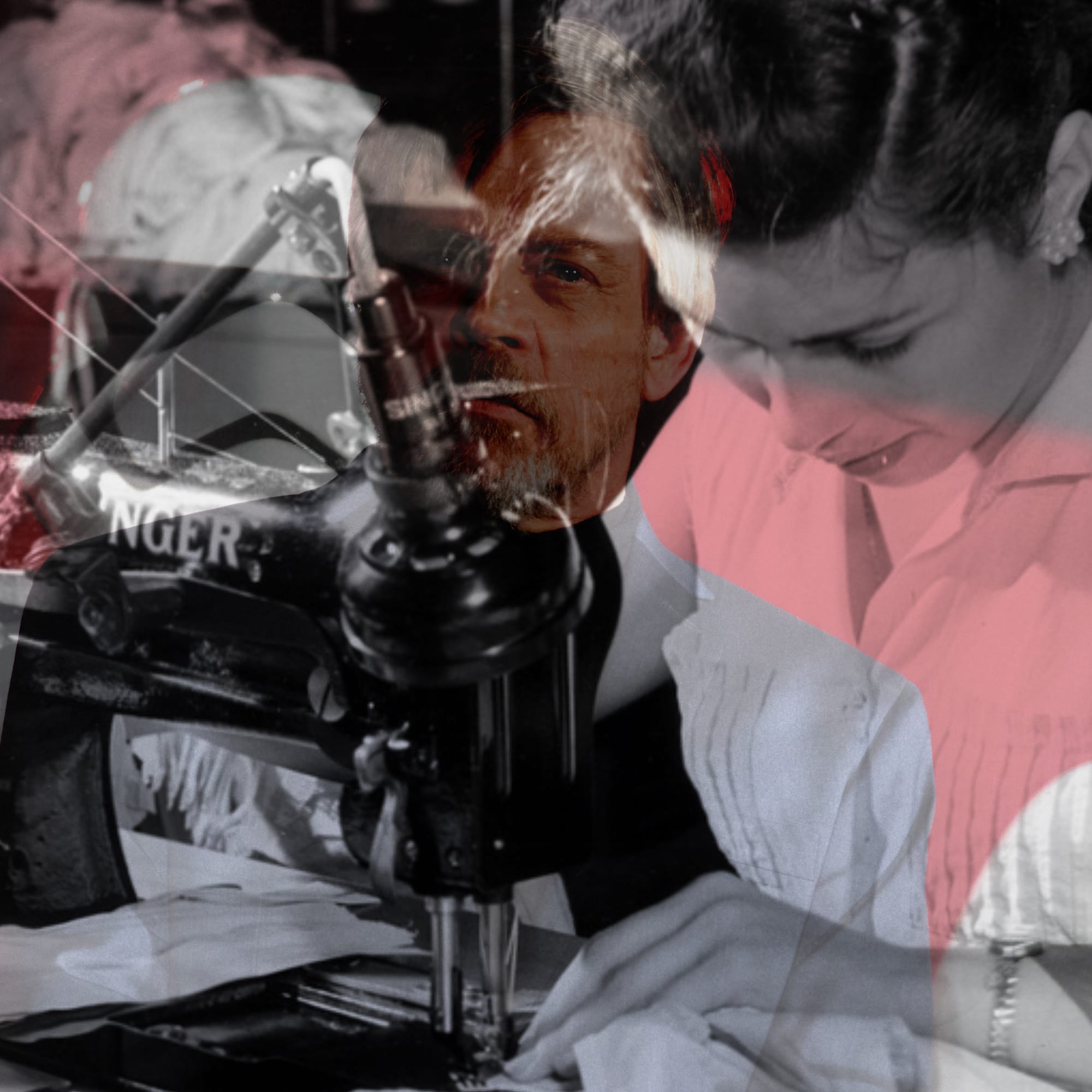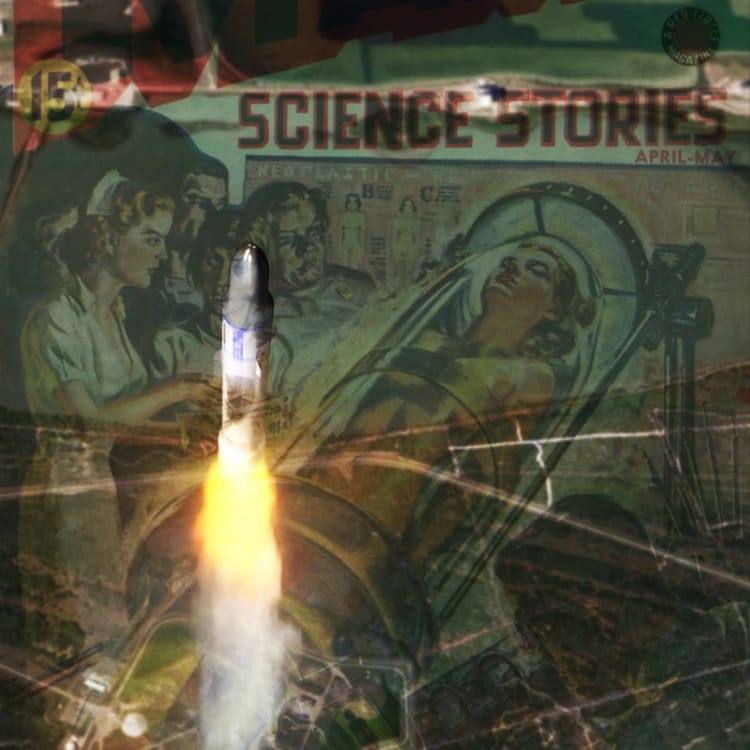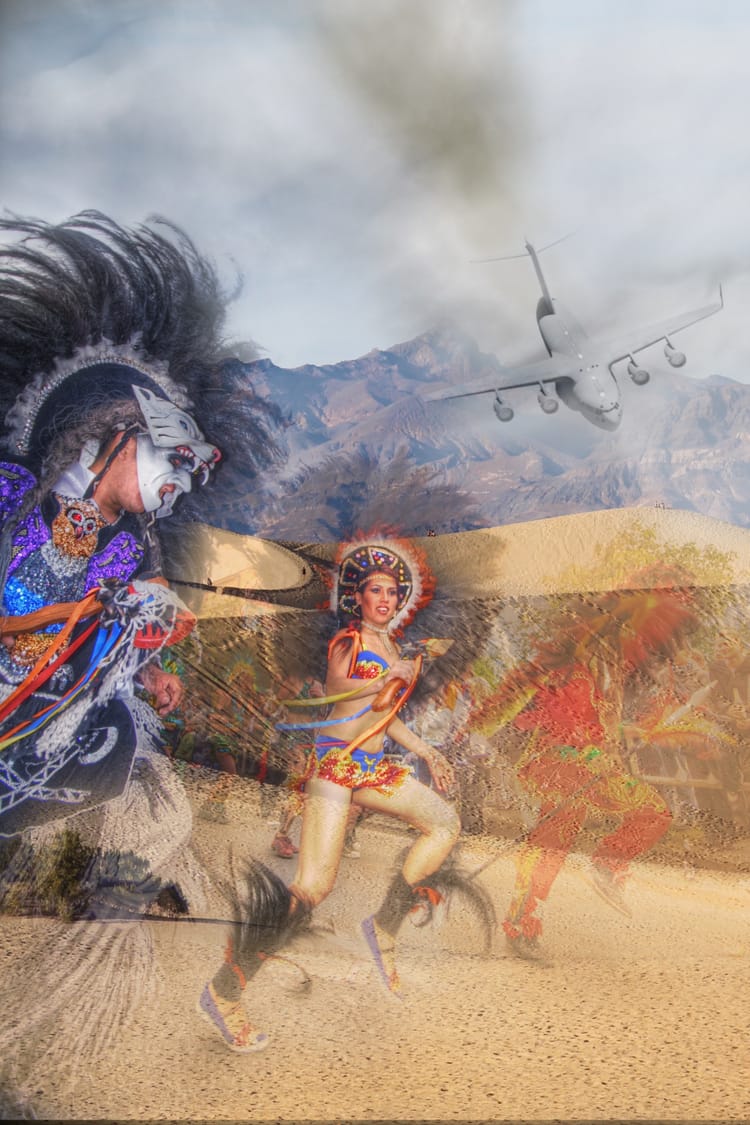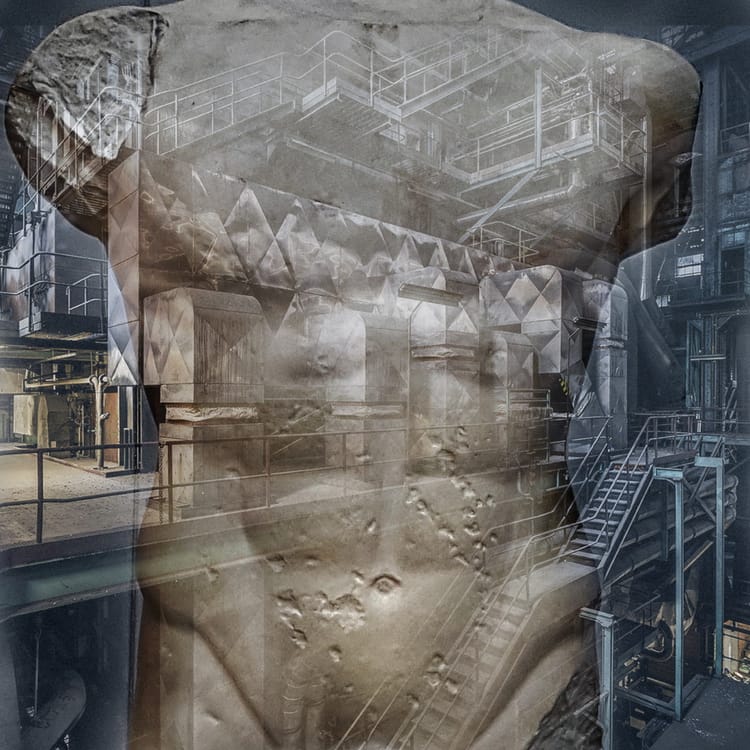Decline and Fall: Dressing the Empire with Tansy Gardam

Saul here. You could never have gotten 10 year-old me to believe it, but more than the spaceships, more than the lightsabers, Star Wars is a series about clothes.
Or costumes, if you like: outfits, uniforms, armor, masks. The broken-in World War II bomber chic of rebel pilots, the plastic chintz of stormtroopers, the flowing sartorial robes donned by Senators to aid in verbal combat.
In fact, the series’ core drama — the rise and fall of Anakin Skywalker — rests on a series of wardrobe changes. He starts as an enslaved child in sun-bleached workwear, which he trades for a flowing blouse when he joins the Jedi, followed by a black smock and black robes as he throws in with darkness. As Darth Vader, his mutilated body is wrapped in an amalgam of cloth, plastic and metal. When he is redeemed, he disrobes, pulling the helmet off.
While most viewers will only notice those costume changes subliminally, they work like the series’ famous score. They drape the plot and characters in the literal trappings of a fully realized world.
And as our correspondent Tansy Gardam argues, the choices behind that extra-galactic fashion are effective because they themselves rest on a tangled, tragic history right here on Earth.
Welcome to Heat Death, the newsletter that believes dress-up is deadly serious. Our contributor today is Tansy Gardam, acclaimed creator of the podcast Going Rogue and a keen observer of all that goes on behind the mask of culture.
In the essay that follows, she argues that Star Wars fashion offers a secret history of our own world: an insidious story of slavery, empire and the dark side of rebellion.
A couple programming notes before we start. First: pitch us! In the howling wasteland of AI slop, quick takes and the most dispiriting and enraging political news of my lifetime, we’re building a humble intellectual haven: a place of thoughtfulness, creativity and authentically weird shit. If you have a story that you think bespeaks Heat Death — a notoriously slippery category — send it along!
Second, and relatedly: We’re able to commission work from folks like Tansy — and the many other writers we have on deck these next few months — thanks to your subscriptions. As we grow the newsletter, we’re plowing all of the money you send us directly into commissioning stories. So if you like what we do here, we ask you to subscribe.
And now: how clothes maketh the Jedi. This is Heat Death. Stay with us.

Dressing the Empire
Tansy here. Ever noticed that Luke Skywalker wears Levis?
They’re hard to see, between his long Kurosawa-inspired shirt, knee-high suede puttee wraps and the blanket he’s wearing as a poncho, but beneath it all is a pair of bleached denim jeans.
The final look, like everything else in A New Hope, is such a wild mix of styles that it became its own thing, redefining its disparate parts into a new whole. But before that look was quintessentially Star Wars — now a costume genre in its own right — it was inspired by what costume designer John Mollo called “a Saxon sort of costume.” The mix of ethnic styles and “broken down” fabrics allowed Mollo to show “[Luke] was a very simple, homespun country boy…we used very cheap materials, so he’d look sort of worn, and really unsmart.”
Let’s zero in on the implications of one word Mollo chose to describe Luke: “homespun,” a word with strong roots in the history of textiles.
Homespun clothing is usually coarse, with a looser weave which comes out of the nature of its production: not only home-made but home-woven from threads that have been home-spun out of natural fibers like wool or flax. Levis don’t fit this technical definition of homespun — they are the epitome of machine-made clothing — but Mollo’s use of the word for Luke’s costume points to the far broader cultural meaning the word has taken on: one which reflects Star Wars’ deep connection to American notions of rebellion, and the way film costuming is always filtered through our own unspoken understandings of fashion.
When we look at human history, textiles and clothing weave nations and civilizations together. Just as the smartphone can trace its lineage back to the abacus, so too can we trace a breezy linen shirt to thousands to years of hardy flax plants being retted, broken, scutched, hackled, spun, woven and finally sewn into garments. Human history is, if you’ll pardon the pun, woven into every piece of clothing worn, and even if you insist you have no interest in fashion, the choice to scorn it is still one you reflect in how you dress.
But despite (or perhaps because of) the fact that we engage with the social language of clothing every day, costuming is one of the more under-appreciated elements of filmmaking. Its effect is often subliminal, projecting and reflecting character — the costume department’s work often ends up being attributed to an actor’s performance rather than judicious use of clothing. The Social Network is a masterclass in character costuming, from Mark’s hoodie and flip flops to Eduardo’s aspirational mid-range suits (since his Prada’s at the cleaners). Mark Zuckerberg’s real world love affair with the hoodie changed the standards of acceptable office attire (before he started dressing like a time-travelling Roman fuckboy). In spite of this, costuming was not among the slew of Oscars that The Social Network was nominated for: the nominees that year were all either period pieces or fantasies, films that drew attention to their costuming rather than making the most of mundane, “regular” clothing.
But no matter how fantastic or mundane a costume is, it is up to the audience to observe that costume, so it must play with the language of clothing we understand, even if we couldn't articulate why certain verbs and nouns are ordered the way they are. Gold is associated with opulence. Heavy-duty cotton twill is still the choice of manual labourers. Eastern-inspired silhouettes and accessories are still used to give characters a “foreign” or otherworldly look. So when Luke is “homepun,” – even in Levis – that choice goes back to the rebellion at the heart of the American identity.
In early Colonial America, imported English fabrics were used for clothing, while rougher homespun cloth was kept within the home, used for things like bedlinens and curtains. But after a series of restrictive British textile import laws, it became an act of public resistance to wear homespun clothing. During this period, the meaning of the word shifted, taking on patriotic notions. “Homespun” became a blanket term for textiles produced within the American colonies, not necessarily in one’s own house — foregrounding the act of anti-English resistance and creating a cohesive American “homeland”. This presaged another sartorial act of defiance during the Civil War, when textile supplies from the North were cut off. Southern women, belonging to a group literally and figuratively styling themselves as rebels, proudly wore “homespun” fabrics as a sign of their independence — a move that conveniently ignored who was actually doing all the textile production in the South at the time. Ironically, in South Carolina, laws prevented enslaved people from wearing anything but the cheapest, meanest fabrics available: white woollen plains, broadcloths and, most often, homespun.
The antebellum South was (and is) home to one of the few fibres whose place in history is regularly culturally interrogated: cotton. A combination of good growing conditions and new ginning technologies increased demand for enslaved labour, helped build the plantation economy of the slave lords, and solidified the Trans-Atlantic slave trade. Cotton’s entanglement with systemic oppression didn’t stop with the Civil War but continued through share-cropping —- something recently highlighted in Ryan Coogler’s Sinners (my movie of the year, with exceptional costumes from designer Ruth E. Carter). Cotton was both the product of hard labour and became a hard-wearing product in its own right: a versatile material that can be woven into lightweight, breathable garments as well as thicker twills and denim — a smart button-down, a t-shirt, or coveralls or trousers suitable for hard labor in hot climates from Tennessee to Tatooine. On Sinners, Stack’s blue baker-boy cap was made of denim to represent workwear. And few cotton garments are more ubiquitous than jeans.
Given their place in American history, it’s not surprising that John Mollo considered Levi jeans to be part of a homespun hero look. Jeans have had a storied history in the United States. Beginning as gold-rush era waist overalls, they transitioned to workwear, took a detour through cowboy films as a means of evoking the hardscrabble frontier look, and then were adopted by the more subversive side of postwar youth culture. They're hard-wearing, long-lasting and mould over time to fit the wearer. (This is no longer true today, by the way: fast fashion mandates have brought in cheaper, light-weight and often elastane-shot denim, particularly for women's jeans.) And as a historically all-American product, they are culturally homespun, if not — you might say — practicing.
(Levis in particular tell a classic American story. In a fairer world, they might be named after tailor Jacob Davis, who came up with the idea of reinforcing the weak points of the pants with rivets. But Davis couldn’t afford to patent the idea, so the iconic American pants bear the name of the cloth supplier who funded and subsequently owned the patent — Levi Strauss.)
Star Wars has always been an outlier and a trendsetter in its costuming, its “used universe” aesthetic extending to clothing: in Brandon Alinger’s book Star Wars Costumes: The Original Trilogy, John Mollo wrote that George Lucas’s first directive for the costumes was that he didn’t want anyone to notice them. Mollo remembers Lucas as a shy man who was not the easiest to talk to and looked more like an undergraduate than a director — a take informed, no doubt, by Lucas’s own favored costume of jeans and flannel.
Lucas, Mollo recalled, had already given the film’s costumes a lot of thought: he wanted a casual Western look for the Rebels, and an efficient German military flavour for the Imperials. In that alone we can read much about Lucas, Star Wars and the American perspective his movies would embody: a world where the bad guys have already reassuringly been defeated, and one that plays into the self repeating myths of the American West. We can also read a lot about Lucas’ theory of fascism itself: that it is an ideology with a specific look, one of uniformity that harkens back to imperial and colonial periods of history. (We might note that the American West was as well, of course. But the costume of fascism is rigorously enforced by its leaders, rather than self determined.)
Considering its contemporaries, one of the most daring decisions of those original Star Wars costumes was to set aside the flashy, metallic, synthetic look of 1970s sci-fi — according to Mollo, George Lucas “strongly believed that the costumes should be real clothes, and if they were noticed too much they would distract the attention of the audience, which nowadays some say is the basis of all good costume design.”
It would be nice to say that this ethos of invisible choices is the reason that good costuming is often overlooked — that, like good sound mixing or good dialogue, it draws an audience in so much they don’t even consider the effort that has gone into creating something effortless. But there’s a less cerebral reason for the relative under-valuing of costuming: it’s seen as girly. Fashion, and by extension, costuming is frivolous and fickle, a useless and self-involved industry that just happens to drive enormous sections of the economy and require constant, everyday participation from all but the most committed of nudists.
Lucas’s ideal of real clothes in an unreal world relied on the audience’s idea of what and who was “real” — Luke’s jeans and Leia’s silk crepe de chine dress were made from natural fibres in an unnatural world, while the vacuum-moulded plastic stormtrooper uniforms were too clean, too shiny, too disposable to consider the human beneath. But to simply write off the Star Wars costumes as “real clothes” undersells them: there is a thoughtful, informed logic behind the rules of the costumes. Much has been made over the years of Georgie Lucas’s insistence that Carrie Fisher couldn’t wear a bra because there was no underwear in space, but less attention is given to his rule against visible zips, buttons and laces. Rebel layers hang loose and open while Imperial costumes are shut with efficient, invisible fastenings — a slight, unfamiliar touch that you don’t really pick up on until it’s pointed out, but one as quintessentially Star Wars as capes and over-engineered belts. Small touches that remind you that this is an alien world, while others remind you of home.
Mollo would win an Oscar for the first Star Wars film, and also act as costume designer on Empire Strikes Back before Aggie Rodgers and Nilo Rodis-Jamero took over on Return of the Jedi. Trisha Biggar’s work on the prequels was initially derided as too excessive in comparison to the stripped back, cowboys-and-Nazis of the original trilogy, but has since been understood as the luxury that was lost under the Empire: the Weimar aesthetic of a galaxy far far away.
Part of the challenge of costuming Andor was the need to bridge that gap between the worlds of Prequels and Original Trilogy, and costume designer Michael Wilkinson found that dividing line in the trappings of wealth and its absence. Mon Mothma wears pristine flowing layers and jewellery as armour to distract from her true allegiances, but Bix’s workwear is all tough, worn down practicality. The Narkina 5 Prison uniforms are not only dehumanising, they are disposable — when the Empire dumps its prisoners there, it also entombs them in polyester. By virtue of the narrative, spy characters like Cassian, Luthen and Kleya switch between the twill and grime of the Rebel underworld and the pristine pomp of high society, and in doing so they draw attention to the interaction of costume and performance.
Creator Tony Gilroy has said he initially worried that Luthen’s double identity would turn Andor into “a show about hats,” where Luthen was constantly switching between disguises — a fear that was allayed by both the casting of Stellan Skarsgaard and the relative simplicity of the character as “two sides of the face.” But at the same time, Andor is not not a show about hats. Cassian insists that all it takes to steal from a smug Empire is a uniform, some dirty hands and an imperial toolkit — which is to say, costume, makeup, props. Luthen’s code switching between what the production called “Natural Luthen” and “Gallery Luthen” is performance driven, but it’s also backed up by jewellery, loose flowing layers and sumptuous fabrics and colours. And while Andor occurs between two fictional time periods, the audience are still Earthbound humans, informed by our history more than that of the galaxy far far away. Star Wars did not have a Roman Empire, or labour-intensive Tyrian dyes and sumptuary laws, but it’s no co-incidence that purple is the first colour we see Gallery Luthen wear.
With the introduction of Ghorman, Andor also became the first Star Wars installment to really take textiles seriously, as an industry and a point of national pride. The design and aesthetics of Ghorman were clearly patterned after Nazi-occupied France, but the cultural soft power the planet wielded for generations also bears a strong resemblance to that once held by China through the production of silk. (The name may have been diluted by history, but there's a reason it was called the Silk Road).Despite its historical value and economic power, silk has always been seen as a feminine and decadent fabric, and it’s telling that while the bolts of “Ghorman Twill” shown in Andor have the lustre of silk, the clothes worn by the Ghor people tend towards matte finishes and worsted wools.
Andor’s costume designer Michael Wilkinson deliberately sought to separate the Ghor style from the more ostentatious Chandrilla or Coruscant — he wanted it to stand for “everything good about humanity, everything worth saving and fighting for, because it’s a culture that actually gets crushed and erased by the empire”. But that intention invites the question of why these looks are everything good about humanity: the Ghorman costuming fits within the audience’s understanding of bespoke, well-tailored and well-made garments from European tailors. Why the audience is expected to think of that as the pinnacle of understated style has as much to do with empire as with the image of a cowboy as a straight-shooting, honest good guy. That heavy European coding therefore invites less comfortable questions about what isn’t worth saving and fighting for. The clothing of the people of Jedha, eradicated in Rogue One, heavily coded as Middle-Eastern: were its wearers somehow less deserving of survival than the Ghor? What about the workwear-clad people of Ferrix, or the feral children of Kenari?
The French Resistance coding of Andor has, in some ways, outlived the show: at an Andor Emmys For Your Consideration event this month, Lucasfilm released a “zine” titled Rebelión, filled with behind the scenes details and mock-propaganda posters. The zine’s name (and indeed some of the formatting) took its queue from Résistance, a dissident French newspaper published during Nazi occupation by a collection of intellectuals and academics known as Groupe du musée de l’Homme. Only a few issues of Résistance were published before the group were betrayed and captured: many were executed or killed in concentration camps, while some like Agnes Humbert were sentenced to five years of forced labour. Humbert, an art historian in her 40s, was initially relieved to learn her sentence would not be carried out in a munitions factory, (unlike Cassian’s forced labour in Season 1 of Andor) but instead producing rayon, a semi-synthetic textile made out of wood pulp. Spinning silk-like threads from pulp requires a heavy, industrial and chemical processing: Humbert and her fellow forced labourers were not given the protective garments their free male predecessors had worn, and many were rendered blind or experienced psychological damage from the caustic carbon disulfides they were exposed to.
The Humbert story is a reminder that real world atrocities and fascism are often pettier than we give them credit for. The factory that Humbert worked in was a profit driven enterprise, and the threads that imprisoned workers produced went into artificial silk stockings, filling a gap in the market left when silk production was diverted to the war effort. Humbert may not have been making bombs, but her work still supported the Nazi war machine. Andor looked more explicitly at empire, fascism and oppressive regimes than its predecessors in the Star Wars galaxy, but it still parsed its understanding of those systems through direct military might — Ghorman was destroyed for its natural resources, not its known cultural products, and Cassian was forced to build part of the Death Star, not the Imperial uniforms that Lucas and Mollo nonetheless understood as a crucial part of developing and maintaining an oppressive regime.
There is always some comfort in fictional depictions of Empire, because almost inevitably, those empires eventually fall. Fascism “eats its young,” in the words of Tony Gilroy, and it is a system that cannot be sustained because all the big fascist enemies of the past have been defeated — or at least, the ones that we are willing to call fascist. No matter how morally complicated the characters, there is a clear line between sides, between good and evil, because there is the side the story is being told from, and the one it isn’t. And regardless of the history and worldbuilding of a fictional universe, the signifiers of those sides need to be parsed by a contemporary audience, who will use and reinforce any biases they have. You dress the villains as Nazis, and put Luke Skywalker in Levis.
Rayon is still produced under a number of names, by the way: viscose, cupro, lyocell, bamboo, modal. It breathes and biodegrades, unlike fully synthetic fibres like polyester, so it is often marketed as a greener choice, and in many ways it is since it is made from natural wood products rather than petroleum. It can be produced in a minimally hazardous manner: when proper protections are in place, the toxic carbon disulfide is recycled instead of released into breathing spaces, which allows manufacturers to re-use the carbon disulfide and reduce costs. This is the case at the Lenzing viscose plant in Austria, where a team of medical specialists also closely monitor employees for signs of increased disulfide absorption. But most rayon production is now done in the global South, where it is subject to far less rigorous safety measures and monitoring, affecting both factory workers and the surrounding environment. While the country a garment is constructed in is recorded on the label, along with the fibre content, the stage in between where those fibres are processed, spun and woven into usable fabrics is largely unaccountable, except in voluntary declarations from brands. In an on-the-nose reminder of empire, some mid-range Australian brands will proudly declare that their clothes are made from “European fabric”.
Let’s end, then, by considering what you are wearing. Where was it made? Who profited from its purchase? What environmental damage may have been done in its production, and will happen in its disposal? Do you make assumptions about its meaning, classiness or style, and are those assumptions informed by Eurocentric ideals of style or American notions of rebellion? Do you own any Star Wars t-shirts, jackets, hats, or other branded clothing?
What conditions were they manufactured under?
Tansy Gardam is the writer, producer, and podcaster behind Going Rogue, a show about the film industry and the troubled road many productions walk. We here at Heat Death love it, and can't recommend it highly enough. You can find her on Bluesky.
This has been Heat Death. Once again, this essay was supported by paid memberships to this newsletter. If you'd like to help us commission more work like this – please consider grabbing a subscription or leaving us a tip!
Want to pitch us? Send ideas to aelbein@gmail.com. '
We'll be back soon with more musings on past, future, and all the crises in between. Until next time – see you, space cowboy.







Member discussion